At Codica, we apply agile software development methodology to project needs and customers’ preferences. We decided to create a series of articles devoted to the project development approaches we work with to show you our system and provide a glimpse of our working processes.
There are several approaches to building an application. One of them is creating high-quality and maintainable code, which follows from the advantages of test driven development (TDD).
There is a common opinion that TDD is more time and cost consuming. However, our experience shows that it is the case for the short term only. The TDD approach has obvious advantages in the long run, attracting customers and developers.
To begin with, let’s talk about what test driven development is and then discover why it can be the best option for particular projects.
What is TDD?
Test driven development (TDD) is a software development practice enabling developers to create proper specifications about how their code should be written and implemented. Fundamentally, TDD is a practice when a programmer writes a functional test before building a code.
The idea of TDD originated in the middle of the 20th century, and since then it has been applied in many areas. TDD was afterward rediscovered in 2002 by Kent Beck, an American Software Engineer and the creator of Extreme Programming methodology. He described it in his book Test Driven Development: By Example. This publication is probably the most reliable source of in-depth practical information about TDD approach.
The original description of TDD was in an ancient book about programming. It said you take the input tape, manually type in the output tape you expect, then program until the actual output tape matches the expected output. After I'd written the first xUnit framework in Smalltalk I remembered reading this and tried it out. That was the origin of TDD for me. When describing TDD to older programmers, I often hear, "Of course. How else could you program?" Therefore I refer to my role as "rediscovering" TDD. - Kent Beck
The image below shows a typical test driven development cycle.
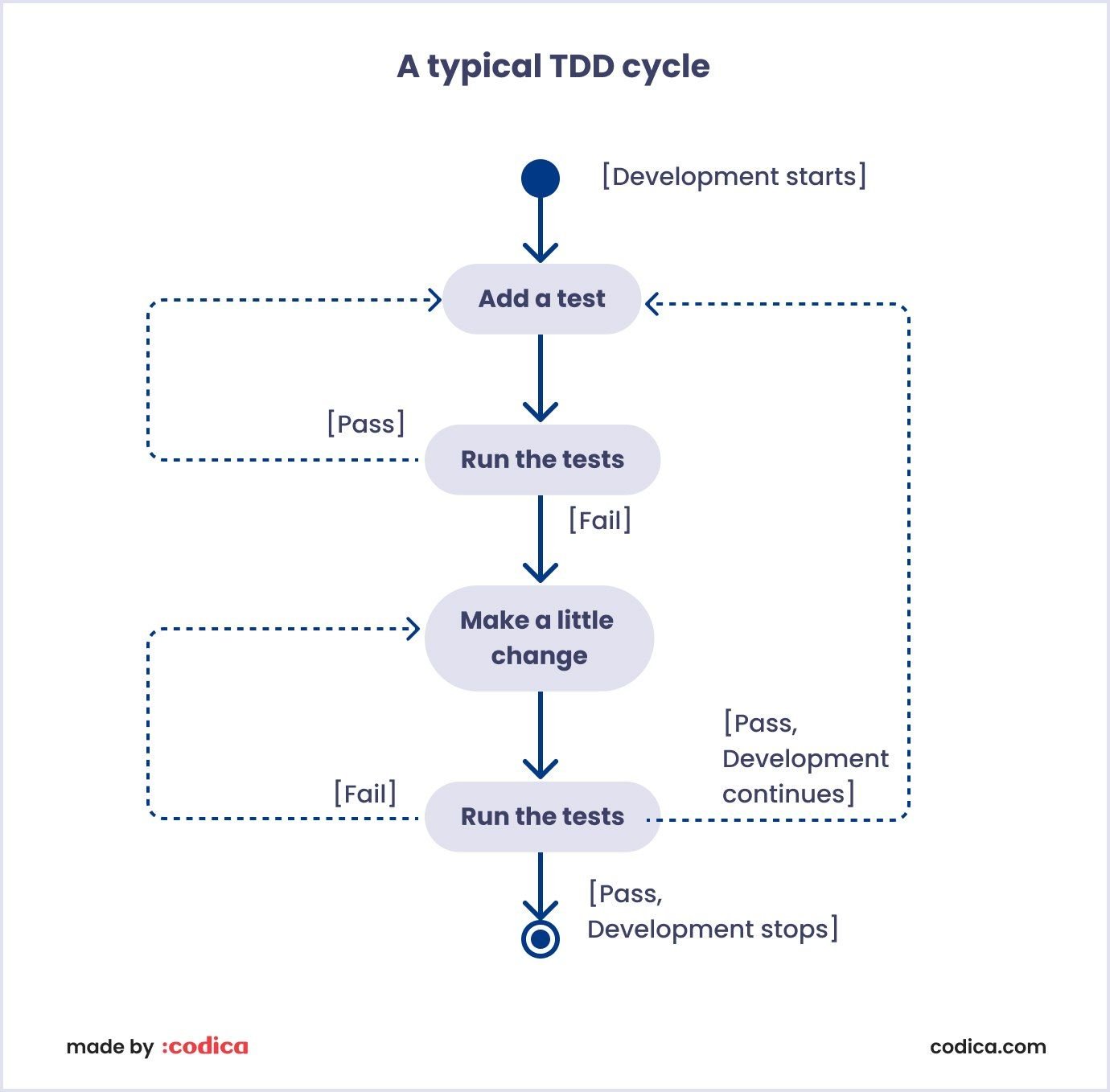
This testing process includes the following stages:
- Writing a unit test first that fails because of code absence.
- Writing a code, after which you can pass the test.
- Refactoring - checking the code structure and its improvement without changing its external behavior. The expected result of refactoring is obtaining a perfectly written code.
By repeating this development process for every single piece of functionality, developers obtain full test code coverage, which will provide several benefits of test driven development, in particular excellent design and easy application maintenance in the future.

What are the advantages of TDD approach?
Let’s take a closer look at the advantages of test driven development methodology, and explore the significant benefits your project will get from this approach implemented.
1. Better code design
When writing a test, programmers must first define a goal they will achieve with the code piece. Developers estimate the experience it will give and how it matches with other elements of the entire code. Specialists keep in mind everything, from an interface and test coverage to a work plan.
Besides, test driven development strongly evolves with the DRY (Don't repeat yourself) principle. Programmers can apply DRY throughout each stage of their projects. This principle helps optimize processes, collaboration, and products.
Next, when developers build code with test driven development usage, it levels up the quality. Do you know why? Because all the possible mistakes and errors are already taken into account. Here, developers write the necessary tests and the code to avoid all failures. Consequently, the code appears to give better results.
Finally, when your code has a clear structure and fits the test requirements, it’s elementary, straightforward, and brief. No massive code blocks are stalling the solution functionality. Even if any, programmers refactor the code to simplify the whole structure.
In a nutshell, there’s a considerable advantage in all of the test driven development aspects. A beautifully-structured code is easier to pass, modify, extend, test, and maintain. The cleaner and more straightforward the code is, the less effort you’ll have to pass modification or updates. And this directly contributes to your project’s success.
Besides, our team shared advice on MVP testing: MVP Testing: Techniques, Strategies, and Plan
2. Detailed project documentation
When writing tests for particular requirements, teams immediately create strict and detailed specifications. They already include all the likely users’ actions.
In this way, we have a scenario determining all the way forward. You don’t need to create any heavy documentation, which relieves you and the programmers of additional efforts.
For the testing to be comprehensive and behave appropriately, programmers proceed from the user's stories. The results of this testing hit with simplicity and consistency, thus making the code as close as possible to all the documentation requirements.
3. Development time
It’s widely known that applications created with test driven development take longer than ones created without TDD. However, as the project progresses, new features will be added and tested, increasing software delivery speed. Testing allows developers for fast refactoring, more accessible code learning for beginners, and minor debugging.
You would probably make a conclusion that the TDD process postpones your project delivery date. But is it really so?
The maintenance of an application made without test driven implementation may take twice as much time as that of an application created with TDD process.
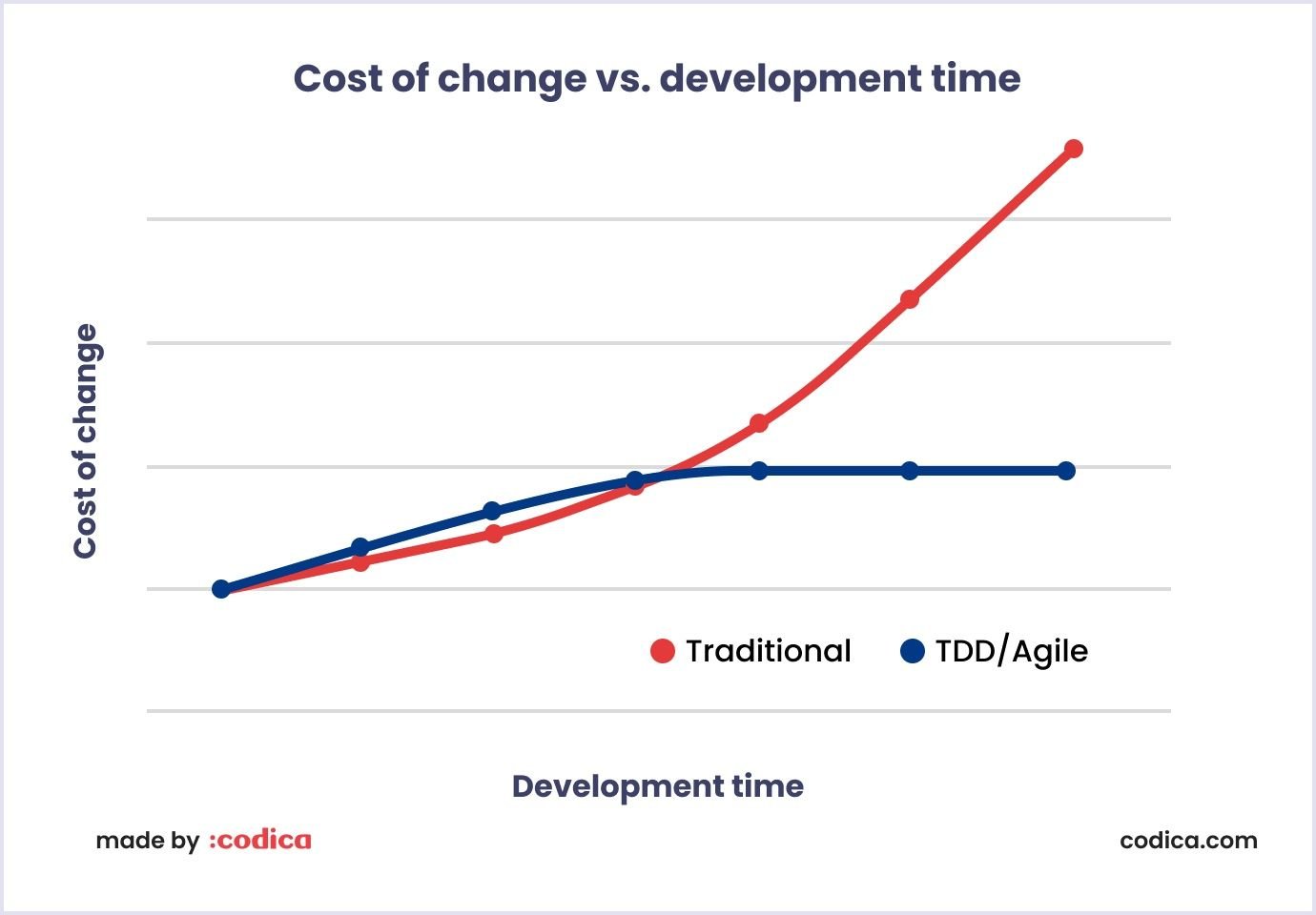
How does it work?
To begin with, the TDD approach allows identifying any issues quickly due to fast feedback.
When writing code without TDD, programmers need some time to understand whether the implementation code will work right or not. With Test Driven Development, when tests fail where they should pass, developers understand that something’s wrong immediately. Consequently, it saves time during the project development process, and a team can fix the code immediately when detecting a breakage.
Secondly, one of the key differences the TDD approach offers is fewer bugs or errors. Having fewer bugs, you will spend less time fixing them - it’s as simple as that.
Which means that less time is spent on the bug fixing or maintenance stage if compared with other development approaches used.
Additionally, provided that the code quality is significantly higher with TDD tests, this will, of course, reduce the time spent on code maintenance.
So we can say that TDD contributes to faster project completion in the long run.
4. Code flexibility and easier maintenance
When writing code, developers strive to get fewer bugs, considerably influencing business spending.
According to the ResearchGate report, implementation of test driven development reduces the percentage of bugs by 80%, which means less time is required to fix them.
Being a part of TDD process, refactoring stands for the optimization of existing code to make it more readable and easy to introduce. This optimization encourages a pure and attractive code structure. Sometimes, even non-developers can read the code and understand its message.
An equally important component is the appearance of the whole structure. Even at the stage of building test cases, developers respect clean interfaces. It means that the actual code already includes this part, and it matches both a client’s and users’ needs.
See also: Agile vs Waterfall Methodology: What is the Best for Your Project
5. Reliable solution
With TDD, both you and developers can be sure about the reliability of the developed solution. That is, tests help to understand if everything goes right after refactoring or adding a new feature.
Let's take a look at the graph below. The unstable blue line means that at some stages of testing and refactoring, people can sometimes get the wrong impression and make hasty decisions about checking code. However, this does not negate the fact that if you test the quality of your code, you will work faster and easier.
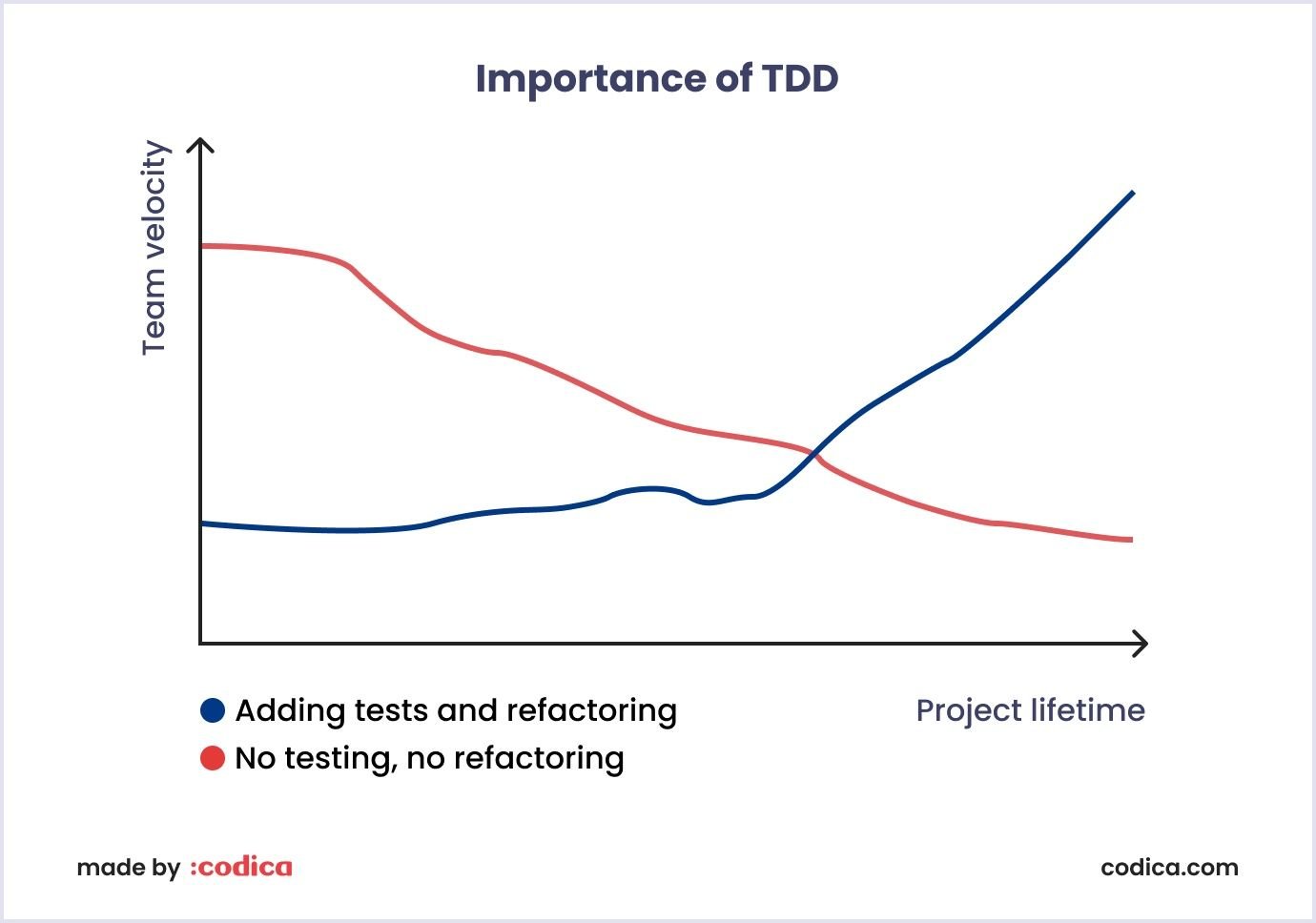
Without TDD, developers go blind with the latest changes, and they are not quite sure how the recent development process will work with the perfect code built previously. And any new changes can break the solution.
Essentially, it’s yet another example of the fact that TDD allows being agile and worrying less about the benefits of further changes.
6. Save project costs in the long run
And last but not least - with TDD, the cost of a project development will significantly decrease.
This is the result of all the advantages of the test driven development mentioned previously, namely the following:
- The code that you will get will be maintainable, flexible and easy to extend.
- The solution will be reliable for any further enhancements or development.
- You will have ready documentation that can be used further on for any purposes.
- The quality of the product developed with TDD is significantly higher.
Considering all the above, with TDD approach such project phases as bug fixing and maintenance will take less time, consequently, this will mean a smaller cost required.
However, once scaled down, TDD does not increase development costs. In fact, after a certain threshold, TDD becomes much more efficient than waterfall. Below you can see how the initial cost of Test Driven Development is offset by the effort saved along the way.

What are the disadvantages of TDD approach?
As with any software development methodology, Test Driven Development also has some pros and cons that can curb the implementation of this technique. Now, let's glance at the main disadvantages in more detail.
1. Committed team
TDD is an all-or-nothing approach. Because the TDD involves code planning, it is recommended that all development team members use either a TDD approach or none. Therefore, each development team member must know and follow the principles of the methodology.
For example, company management is often convinced that implementing the latest features in TDD methodology takes time. Therefore, an essential factor here is that all team members agree on the importance of unit tests.
At first, this approach seems complicated because developers must focus on one thing at a time and write tests before seeing the code.
2. Writing tests probably won't help
Does testing help to find bugs? Definitely. On the other hand, testing cannot detect bugs that developers introduce into test coverage and implementation codes. For example, if you haven't figured out the test cases you want to resolve, writing tests probably won't help.
Below you can see the physics of TDD methodology.
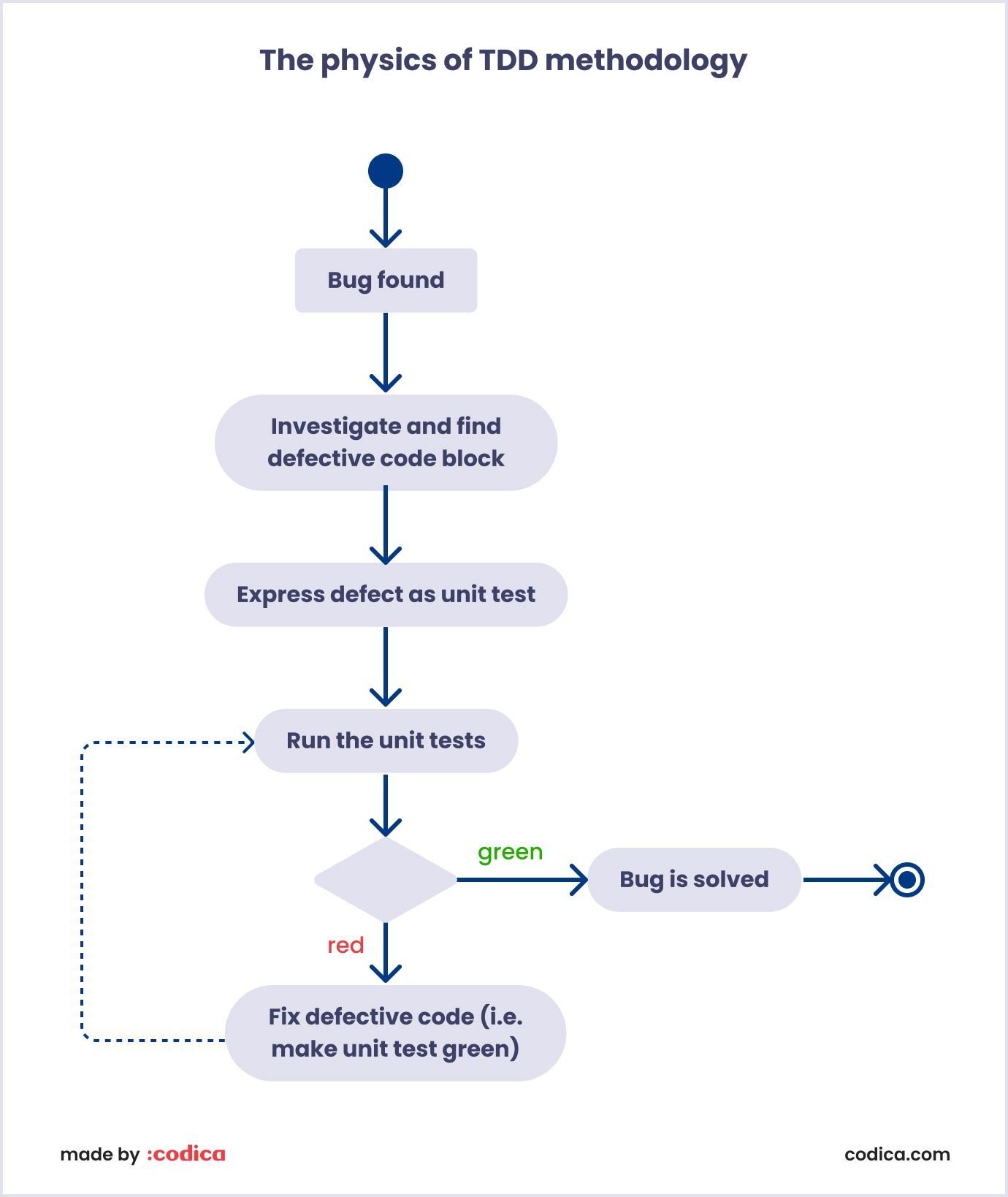
3. Difficult to learn
In fact, Test Driven Development is a rather challenging practice. It requires appropriate skills, perseverance, and experience. If you or your team have never had experience with the TDD approach before, it can be quite difficult to learn its principles and adapt to them.
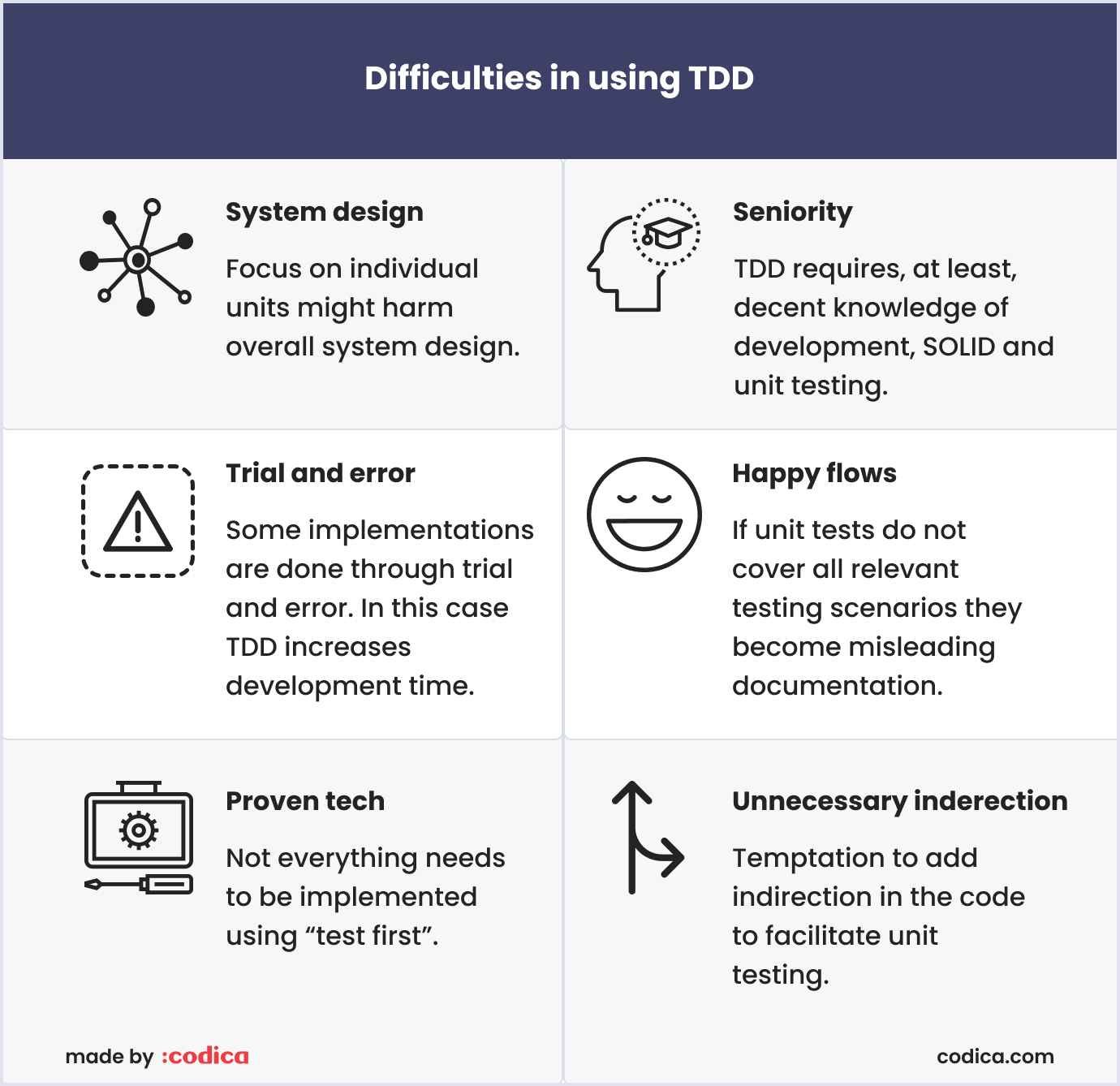
When learning TDD, engineers encounter numerous misconceptions. It is vital to implement Test Driven Development in the earlier stages of the product, when the structure is still simple enough. This way you can prevent TDD from affecting your time and usage of resources. However, the automation of the success check is a complex process.
However, all difficulties are covered by the ultimate success of TDD. The result will pleasantly surprise you when you cope with gradual work and writing complex detailed tests. As a result, testing will improve the clarity of your code, help with debugging, and support future refactoring.

Is TDD used in agile methodology?
Test driven development goes hand in hand with the agile software development method. Moreover, TDD provides an outstanding contribution to agile methodology. Let’s see how this works.
One of the agile ingredients is Extreme Programming or XP, which gave rise to unit tests and TDD.
The Extreme Programming technique allows developers to write unit tests so that each of them carefully checks a small piece of a software code. Thereby, teams verify whether everything operates correctly. Consequently, TDD enables developers to add, edit, or delete all the features swiftly and efficiently.
According to Zippia, at least 71% of U.S. companies are now using agile. The figure below shows the main benefits of agile adoption (as of 2022). As we can see, 71% of respondents value an agile approach for accelerated software development.

Source: Zippia
Codica’s experience in TDD
Writing tests before implementation helps Codica to get better results in following coding, QA services, and product design. Therefore, code reviews are one of our fundamentals. Our team is convinced that fresh eyes on the code quality guarantee stable, fast-acting, and high-quality solutions.
Moreover, Codica uses an agile approach, and our employees are divided into teams. These are small enough to be mobile, managed independently of each other, and comfortable to be part of.
How about refactoring? We regularly review our projects’ codebases and refactor them to avoid any technical bugs.
At Codica, we help our clients at various development stages: from TDD implementation to scaling, further development, and support. You can see Codica's approach among the best completed projects.
For example, our team used the TDD approach when we developed the workday time tracking tool. This time tracking software boosted team performance and made reporting more straightforward than ever. With this Timebot for Slack, you can access overall performance statistics on individuals, teams, and projects for any period and at any time.
Using the TDD, we set up our time tracking software using an administration panel. It provides visualized insights on what tasks and projects teams or their members are working on. We configured the generation and sending of reports according to the specified intervals and triggered tasks. With our custom software product development services, this time tracking software allows our project managers to receive accurate performance reports on demand.
Below you can see how this time tracking software looks like.

Bottom line
To wrap this up, we can certainly assume that the implementation of test driven development significantly improves project results.
Additionally, we can undoubtedly say that developers who work with the TDD approach have more structured thinking and usually provide better estimates. This, of course, brings more benefits of this approach in project development.
There are a variety of best practices for strengthening the final code along with TDD, such as Continuous Integration/Continuous Delivery, Code Reviews, Refactoring, and others. But to get a solution that meets all your test requirements, you should consider other obstacles apart from the technology.
At Codica, we have expertise in applying all the best practices, including TDD, as appropriate. Our case-by-case approach and vast experience allow us to choose the best techniques to suit your business perfectly. By the way, if you want excellent and efficient software development, you are welcome to contact us.
